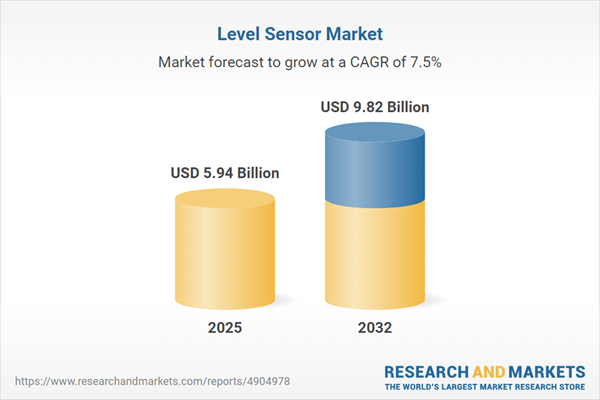Speak directly to the analyst to clarify any post sales queries you may have.
Level sensor solutions are transforming industrial operations by providing precise measurement and real-time data that empower enterprises to enhance operational effectiveness, comply with evolving regulations, and navigate shifting market demands confidently. Senior decision-makers benefit from these technologies through robust support for automation, compliance, and operational transparency.
Market Snapshot: Level Sensor Market Growth and Outlook
The global level sensor market is advancing steadily, with revenues expected to climb from USD 5.52 billion in 2024 to USD 5.94 billion in 2025, and further to USD 9.82 billion by 2032. This trajectory is underpinned by the expansion of industrial automation, rising demand for precise measurement in chemicals, energy, and water sectors, and the ongoing prioritization of digital transformation. Organizations are focusing investments on technologies that drive compliance, sustainability, and more resilient supply chains. As markets evolve, demand for reliable, continuous monitoring continues to shape development pathways and competitive strategies.
Scope & Segmentation of Level Sensor Solutions
- Material Applications: Monitor liquids, powders, granular, and bulk substances across industries to maintain effective inventory control, ensure process safety, and track production output.
- Installation Types: Deploy clamp-on, insertion, external, or submersible sensors that accommodate both new construction and retrofit projects, minimizing process downtime and adapting to facility needs.
- Sensor Technologies: Leverage capacitive, float switch, magnetostrictive, laser, optical, radar, and ultrasonic sensors, each suited to distinct material properties and environmental conditions for high-precision performance.
- End Use Industries: Solutions are critical in chemicals, oil and gas, power generation, pharmaceuticals, food and beverage, metals and mining, and water and wastewater management, where operational reliability and stringent compliance requirements prevail.
- Regional Markets: Product offerings address a variety of regulatory and operational standards across the Americas, Europe, Middle East, Africa, and Asia-Pacific, enabling alignment with both local and international business strategies.
- Leading Companies: Emerson Electric Co., Siemens AG, ABB Ltd., Honeywell International Inc., Schneider Electric SE, Endress+Hauser, VEGA Grieshaber KG, ifm electronic, Pepperl+Fuchs, and KROHNE remain central to industry innovation and supply assurance.
Key Takeaways for Senior Decision-Makers
- Level sensors increase visibility across operations, enabling better risk management and more agile production adjustments in competitive markets.
- Advanced integration identifies material inefficiencies and supports sustainability goals while simplifying the achievement of regulatory milestones.
- Deployment flexibility lets organizations adapt measurement systems to dynamic compliance requirements and new production priorities, ensuring consistent operations.
- Diversifying supplier networks and engaging with core technology partners fortifies the supply chain against market and logistical disruptions.
- Customizing sensor specifications to match hygiene and safety protocols maintains optimal equipment performance in industries governed by strict regulatory standards.
- Monitoring global compliance trends positions leadership to proactively address new risks and unlock strategic growth opportunities amid shifting market requirements.
Tariff Impact and Strategic Partnerships
New tariff adjustments anticipated in the United States for 2025 are influencing sourcing and procurement activities within the level sensor sector. Executive leadership teams are actively reinforcing engagement with principal suppliers and technology partners to safeguard operational adaptability during shifts in the trade environment. This strategic focus supports continued resilience in implementation and supply continuity.
Research Methodology & Data Sources
Analysis is based on validated industry data, the latest regulatory guidelines, comprehensive company disclosures, and interviews with market stakeholders. A peer-reviewed approach and data triangulation ensures the insights are accurate and relevant for executive decision-making.
Why This Report Matters
- Enables leadership teams to anticipate regulatory shifts, benchmark sustainability outcomes, and track advancements influencing adoption in key industries.
- Supports identification of actionable growth opportunities and fosters robust risk management by examining trends across segments and geographic markets.
- Equips organizations to optimize procurement strategies, maintain compliance, and enhance resilience against ongoing industry changes.
Conclusion
Level sensor systems are foundational to achieving sustainable automation, maintaining compliance, and adapting rapidly to evolving industrial challenges, ensuring continued operational success and strategic market positioning.
Additional Product Information:
- Purchase of this report includes 1 year online access with quarterly updates.
- This report can be updated on request. Please contact our Customer Experience team using the Ask a Question widget on our website.
Table of Contents
3. Executive Summary
4. Market Overview
7. Cumulative Impact of Artificial Intelligence 2025
Companies Mentioned
The companies profiled in this Level Sensor market report include:- Emerson Electric Co.
- Siemens AG
- ABB Ltd.
- Honeywell International Inc.
- Schneider Electric SE
- Endress+Hauser Management AG
- VEGA Grieshaber KG
- ifm electronic GmbH
- Pepperl+Fuchs GmbH
- KROHNE Messtechnik GmbH
Table Information
| Report Attribute | Details |
|---|---|
| No. of Pages | 199 |
| Published | November 2025 |
| Forecast Period | 2025 - 2032 |
| Estimated Market Value ( USD | $ 5.94 Billion |
| Forecasted Market Value ( USD | $ 9.82 Billion |
| Compound Annual Growth Rate | 7.4% |
| Regions Covered | Global |
| No. of Companies Mentioned | 11 |









